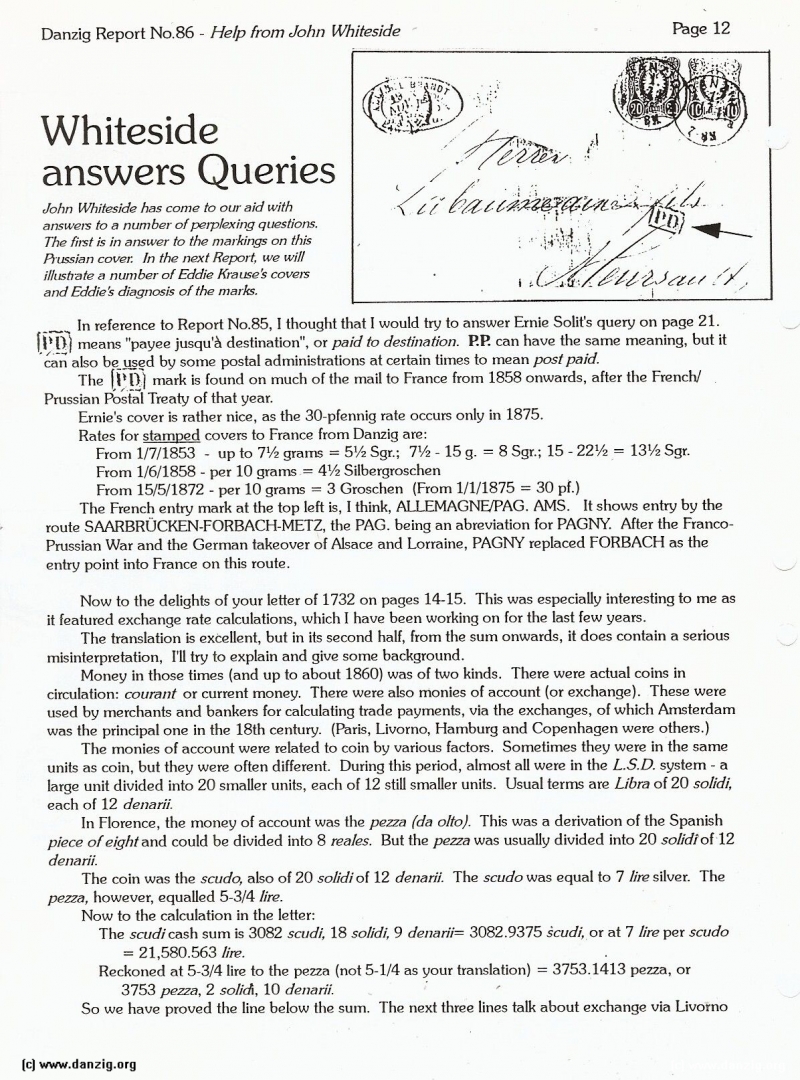
Whiteside answers Queries
John Whiteside has come to o aid with answei to a number of peiplexing questions. The first is in answer to the n;athings on this Thussian cove?: In the next Report, we will illushatea number of Eddie Krausecoveis and Eddies thagnosis of the marks.
In reference to Report No.85, 1 thought that I would try to answer Ernie Solifs query on page 21. means “payee jusqu’à destination”, or paid to destñiation. PP can have the same meaning, but it can also beed by some postal administrations at certain times to mean postpaid.
The PD mark is found on much of the mail to France from 1858 onwards, after the French? Prussian Postal Treaty of that year.
Ernie’s cover is rather nice, as the 30-pfennig rate occurs only in 1875.
Rates for stamped covers to France from Danzig are:
From 1/7/1853 - up to 7’/2 grams = 5½ Sgr.; 7’/2 - 15 g. = 8 Sgr.; 15 - 22½ 13½ Sgr.
From 1/6/1858 - per 10 grams = 4½ Silbergroschen
From 15/5/1872 - per 10 grams 3 Groschen (From 1/1/1875 = 30 pf.)
The French entry mark at the top left is, I think, ALLEMAGNEJPAG. AMS. It shows entry by the route SAARBRUCKEN-FORBACH-METZ, the PAG. being an abreviation for PAGNY. After the FrancoP russian War and the German takeover of Alsace and Lorraine, PAGNY replaced FORI3ACH as the entry point into France on this route.
Now to the delights of your letter of 1732 on pages 14-15. This was especially interesting to me as it featured exchange rate calculations, which I have been working on for the last few years.
The translation is excellent, but in its second half, from the sum onwards, it does contain a serious misinterpretation, I’ll try to explain and give some background.
Money in those times (and up to about 1860) was of two kinds. There were actual coins in circulation: courant or current money. There were also monies of account (or exchange). These were used by merchants and bankers for calculating trade payments, via the exchanges, of which Amsterdam was the principal one in the 18th century. (Paris, Livorno, Hamburg and Copenhagen were others.)
The monies of account were related to coin by various factors. Sometimes they were in the same units as coin, but they were often different. During this period, almost all were in the L.S.D. system - a large unit divided into 20 smaller units, each of 12 still smaller units. Usual terms are Libra of 20 solidi, each of 12 denarii.
In Florence, the money of account was the pezza (da olto). This was a derivation of the Spanish piece of eight and could be divided into 8 reales. But the pezza was usually divided into 20 solid/of 12 de,iarii.
The coin was the scudo, also of 20 solidi of 12 denarii. The scudo was equal to 7 lire silver. The pezza, however, equalled 5-3/4 lire.
Now to the calculation in the letter:
The scudi cash sum is 3082 scudi, 18 solidi, 9 denarii= 3082.9375 cuda or at 7 lire per scudo = 21,580.563 lire.
Reckoned at 5-3/4 lire to the pezza (not 5-1/4 as your translation) = 3753.1413 pezza, or 3753 pezza, 2 solicA, 10 denarii.
So we have proved the line below the sum. The next three lines talk about exchange via Livorno
Danzig Report Vol. 1 - Nr. 86 - January - February - March - 1995, Page 12.
Hits: 3242
Added: 10/07/2015
Copyright: 2025 Danzig.org

